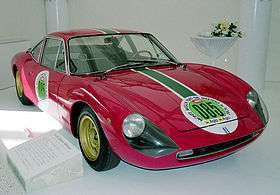De Tomaso Vallelunga
The De Tomaso Vallelunga is a mid-engine sports car produced by De Tomaso from 1964 until 1968. It was the first road going automobile manufactured by the company.
| De Tomaso Vallelunga | |
|---|---|
 | |
| Overview | |
| Manufacturer | De Tomaso |
| Production | 1964–1968 (58 produced) |
| Assembly | Italy: Turin |
| Designer | Carrozzeria Fissore[1][2] |
| Body and chassis | |
| Class | Sports car (S) |
| Body style |
|
| Layout | Rear mid-engine, rear-wheel-drive |
| Powertrain | |
| Engine | 1.6 L (1,593 cc) Ford straight-4 |
| Transmission | 4-speed manual 5-speed manual |
| Dimensions | |
| Wheelbase | 2,273 mm (89.5 in)[3] |
| Length | 3,840 mm (151.2 in)[3] |
| Width | 1,600 mm (63.0 in)[3] |
| Height | 1,080 mm (42.5 in)[3] |
| Curb weight | 726 kg (1,601 lb) |
| Chronology | |
| Successor | De Tomaso Mangusta |
History
The Vallelunga was based on a roadster designed by Carrozzeria Fissore[1][2] named after the Autodromo di Vallelunga racing circuit and first shown as a concept car at the Turin Motor Show in 1963.[1][4] De Tomaso had hoped to sell the design of the concept to another company,[4] but when there were no takers had the car produced by Ghia.[2]
Specifications
The engine was a 1.5 L straight-4 Kent engine from the Ford Cortina,[3][4] tuned to a paper output of 104 hp (78 kW) at 6,200 rpm.[2] A Volkswagen Beetle transaxle,[3][2] fitted with Hewland gearsets,[2] was used. The chassis was a pressed steel backbone with a tubular subframe at the rear.[3] Suspension was double wishbone and coil springs at all four corners[4] with front and rear anti-roll bars[3] and with uprights sourced from Triumph. The small car weighed 726 kg (1,600 lb)[2] with a fiberglass body and many drilled aluminium parts.[2] Brakes were disc type all around.[5]
Successor
The chassis was not torsionally sound for engines with higher torque, a problem made worse by faulty welding in the Italian-made backbone. Drivetrain vibration was a constant problem for those cars. 50 production cars were built,[3][2] along with three aluminum-bodied prototypes and five aluminum-bodied racing cars, bringing the total to 58.[3] The Vallelunga was replaced by the Mangusta. The Mangusta used the concept of the Vallelunga chassis, significantly re-engineered to take a Ford 302 engine, all packaged with a body by Giorgetto Giugiaro.[4]
Notes
- Lamm (1991), p. 108.
- Rosetti (2009).
- Lamm (1991), p. 109.
- Lawrence (1997), p. 97.
- Lamm (1991), pp. 108, 109.
References
| Wikimedia Commons has media related to De Tomaso Vallelunga. |
- Lamm, John (September 1991). Thos L., Bryant (ed.). "Salon: 1967 De Tomaso Vallelunga". Road & Track. 43 (1): 106–109.CS1 maint: ref=harv (link)
- Lawrence, Mike (1997) [1991]. A to Z of Sports Cars 1945-1990. Bay View Books. ISBN 1-870979-81-8.CS1 maint: ref=harv (link)
- Martin, Ricci (2004). "Chapter 9—Dean-Paul". That's Amore: A Son Remembers Dean Martin. Lanham, MA US: Taylor Trade. ISBN 1-58979-140-1. LCCN 2001027526.CS1 maint: ref=harv (link)
- Rosetti, Giancarlo (February 2009). "De Tomaso Vallelunga: Just the beginning for Alexjandro". European Car Magazine. Archived from the original on 25 November 2013. Retrieved 2007-10-24.CS1 maint: ref=harv (link)